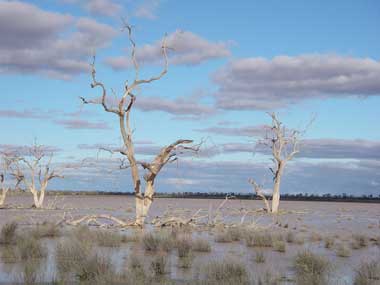Lake Pinaroo is located within Sturt National Park in the arid north-west corner of New South Wales. The lake is the largest terminal basin in the Simpson-Strzelecki Dunefields biogeographic region. Lake Pinaroo only fills when Frome Swamp overflows during intense local rainfall events. However, once full the lake holds water much longer than any other wetland within the region and can take up to 6 years to become dry again as there is no point of outflow. Therefore, it provides a reliable breeding area for a substantial number of waterbirds and is also considered to play an important role for birds migrating from surrounding wetlands including Coongie Lakes and the Paroo wetlands. Generally there is very little vegetation found on the bed of Lake Pinaroo and Neverfail is the dominant species. Coolibah regrowth is found on the high ground of the lake margins. The surrounding sand dune country is vegetated with Hopbush, Turpentine, Saltbush, Budda, and Whitewood. Sturt National Park supports an extremely diverse range of bird species and approximately 150 species have been recorded. When full, Lake Pinaroo supports large numbers of waterbirds and waders and the common species include Pink-eared Duck, Grey Teal, Black-tailed Native-hen, and Wood Duck. The Ramsar site and surrounding areas also provide valuable habitat for a number of threatened species including the Grey Falcon, Australian Bustard, Brolga, Freckled Duck, and Black-breasted Buzzard. Lake Pinaroo also supports a number of native mammals and reptiles such as Forrest’s Mouse, Fat-tailed Dunnart, Sandy Inland Mouse, and Beaked Gecko. Although there are no officially recorded sites of Indigenous heritage in Lake Pinaroo, Sturt National Park has an exceptionally high density and variety of Indigenous sites including hearths, middens, ceremonial sites, quarries and abundant stone artefacts, suggesting that a large Indigenous population once occupied the area. The early explorer Charles Sturt built Fort Grey adjacent to the lake as a base from which to launch expeditions into the Simpson Desert, and there are a number of pastoral industry remnants in the area. The lands within the Ramsar Site are permanently dedicated as National Park and are currently used as a nature conservation area with tourism associated activities.
Lake Pinaroo

Government evidence of impact of climate change:
-
Australian Government and NSW Government, Lake Pinaroo Ramsar Site, Ecological Character Description
Key threats to the Lake Pinaroo Ramsar site are climate change and introduced plant and animal species.
Climate change a The NSW Scientific Committee declared human caused climate change to be a key threatening process in NSW (TSC Act).
Although there is a limited understanding on how future climate change may affect arid areas in Australia; this process may be a major threat to the Lake Pinaroo Ramsar site.
It is thought that the enhanced greenhouse effect is increasing the severity of droughts in Australia; as higher temperatures are increasing evaporation rates (Nicholls 2004).
As rainfall is the key to sustaining the flooding regime for this wetland; further climate change may have determinantal effects on the distribution of flora and fauna at Lake Pinaroo.
The indirect effects of climate change on vegetation cover have also been linked to tree deaths in some areas of NSW (Milthorpe 1991) and the reduction in habitat availability for fauna has been implicated in the reduction of small mammal (Reid and Fleming 1992) and bird populations in arid NSW (Smith et al. 1994).
For many waterbirds the main implications of climate change will be a reduction in the number of breeding opportunities (Chambers et al. 2005).
Fire As a consequence of climate change; the frequency of fire in arid NSW may increase.
The impact of fire on vegetation in this region is unclear as fire frequency and its effect on vegetation has not been well studied however; fire has been observed to cause great change (at least in the short term) to some vegetation types (Milthorpe 1991).
Lake Pinaroo acts as a drought refuge for at least 40 waterbird species it is also important for waterbird breeding and can support populations of waterfowl during flood periods; including the Freckled Duck (Stictonetta naevosa) and Blue billed Duck (Oxyura australis); both of which are threatened in NSW.
In turn; this flooding and drying cycle affects water quality and the distribution and abundance of vegetation; waterbirds; fish and invertebrates. 3.4.1 Hydrology The inundation pattern of wetlands relates to timing (when water is present); frequency (how often filling and drying occurs); duration (period of inundation); extent; depth (the area of inundation and water depth) and variability (the degree to which these features change at a range of time scales) of flooding (Boulton and Brock 1999).
If inundation frequency and duration are used as indicators; this component has merits for determining the duration and total rainfall needed to produce a flood that is large enough to support waterbird breeding and non avian wetland dependent species at the Ramsar site.
The abundance of introduced animal species in Sturt National Park may increase rapidly in response to flood conditions (I.


